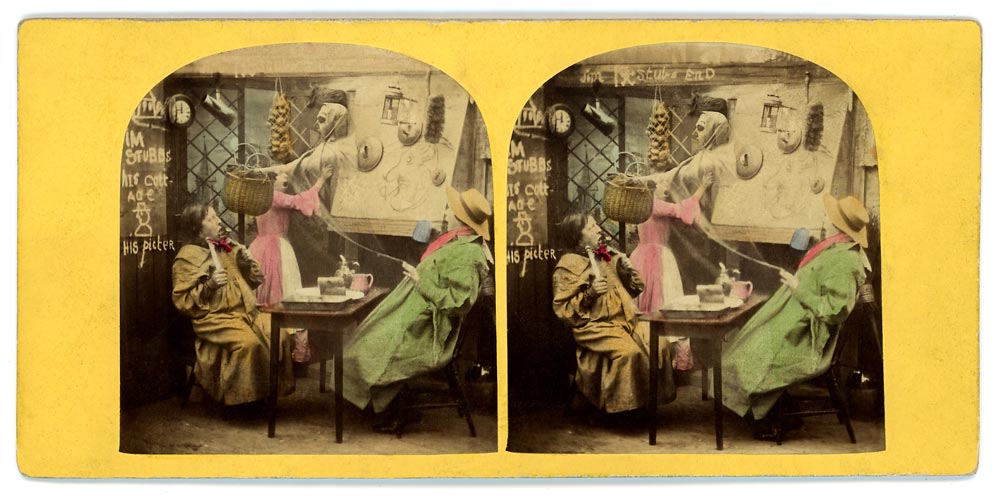Is it possible, for us who live in the 21st century, to imagine or – probably even more difficult – understand what the Victorians saw in the Stereoscope? In 1980 literary theorist, philosopher and semiotician Roland Barthes, confronted to a similar issue, exclaimed, “I want a History of Looking”.1Roland Barthes, La chambre claire: note sur la photographie. Paris: Cahiers du cinéma: Gallimard: Le Seuil, 1980. Chapter 5. The book was translated into English and published in 1981 under the title Camera Lucida: Reflexions on Photography. Ten years later, art critic and essayist Jonathan Crary was certain that “we will never really know what the stereoscope looked like to a nineteenth-century viewer.”2Jonathan Cray, Techniques of the Observer: on Vision and Modernity in the Nineteenth Century. Cambridge, Massachusetts: MIT, 1990. Even when we were not specifically looking for them, we have been bombarded with pictures from an early age and we have seen, looked at, glanced at, stared at, scrutinised, millions of photographs, in albums, on print, on television, and, more recently, on the displays of our smartphones or computers. Can we erase all those photographs from our memory, forget about our image-based culture and get back to the state of mind of a middle-class Victorian seeing their first photograph or viewing their first binocular picture in a stereoscope? We can at least try.
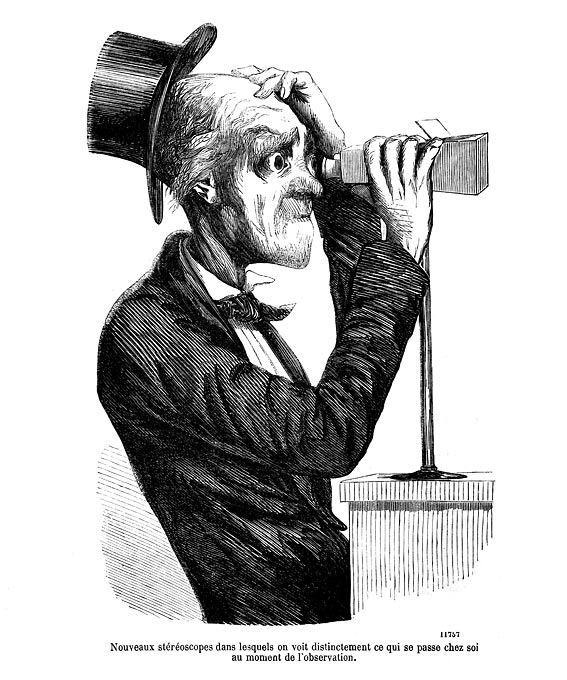
A philosophical toy
Although invented as early as 1832 but only known at the time to the small circle of friends of its creator, brilliant polymath Charles Wheatstone (1802-1875), the stereoscope was presented publicly on 21 June 1838 before the Royal Society of London. On that day Wheatstone read a paper entitled Contribution to the Physiology of Vision – Part the First. On some remarkable and hitherto unobserved phenomena of binocular vision. He also brought with him a rather crudely built device which he called a “stereoscope”, a term he had coined himself from two Greek words meaning “solids I see”.
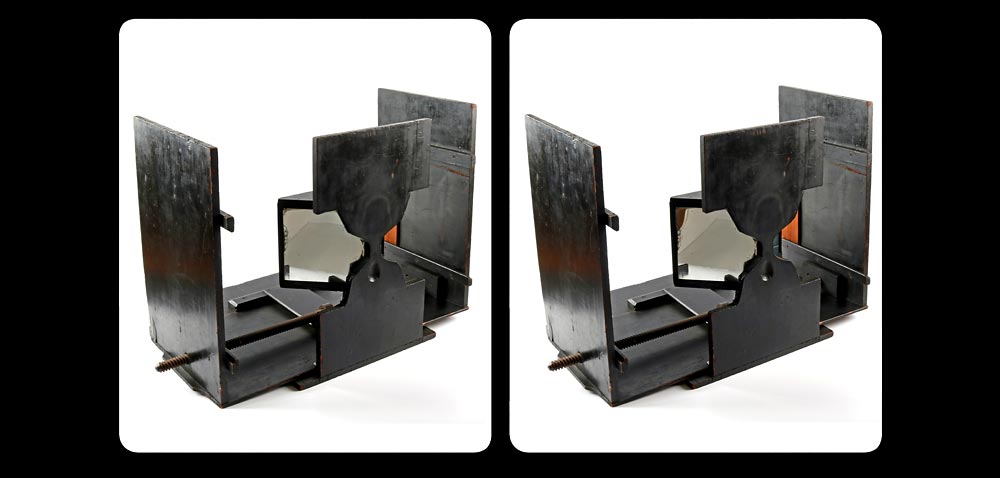
Wheatstone’s stereoscope consisted of two mirrors joined by one of their edges and forming an angle of 90º. On either side of the mirrors and at an angle of 45º were two wooden boards on which images could be inserted or pinned. Those side boards could be moved away from or closer to the mirrors by means of a wooden endless screw, and that was it. Since photography had not yet been revealed to the world, Wheatstone could only illustrate his theory of vision with simple figures he had to draw himself or ask someone to draw for him. The purpose of Wheatstone’s stereoscope was to demonstrate that our perception of depth can be simulated by two flat perspectives of the same object as perceived by each of our eyes and presented in such a way that only the left eye can see the left image and the right eye the other one. Even if photography had been known then Wheatstone would probably have used the same outline drawings. His intention was to eliminate any other depth cues for “had either shading or colouring been introduced it might be supposed that the effect was wholly or in part due to these circumstances, whereas by leaving them out of consideration no room is left to doubt that the entire effect of relief is owing to the simultaneous perception of the two monocular projections, one on each retina.”3Charles Wheatstone, Contribution to the Physiology of Vision – Part the First. On some remarkable and hitherto unobserved phenomena of binocular vision, published in the Philosophical Transactions of the Royal Society of London, Vol. 128 (1838), pp. 376, paragraph 4. Wheatstone illustrated his paper with twelve of these outline figures, a couple of which have survived to this day. The scientific world welcomed his discovery “as one of the most curious and beautiful for its simplicity, in the entire range of experimental optics”4The Athenaeum, No. 567, 8 September 1838, p. 650. Those words were uttered by Sir John Herschel (1792-1871) and the stereoscope entered the physics laboratory. It would most certainly had remained there had not photography been invented. Photography on metal and on paper appeared in 1839 but despite Wheatstone’s early efforts at having photographs made for his instrument by William Henry Fox Talbot, Henry Collen (paper), Hippolyte Fizeau and Antoine Claudet (metal), it wasn’t before the Great Exhibition of 1851 and the modifications brought to the original instrument by Sir David Brewster (1849) and optician Louis Jules Duboscq (1859) who replaced the mirrors with half lenses and made it more compact and portable, that the stereoscope became known to the general public. When the London Exhibition closed its doors in November 1851 only the well-off could buy their daguerreotype portraits for the stereoscope or stereoscopic views on plate of the interior of the Crystal Palace. Everyone else had to be content with series of lithographs featuring white outline geometrical subjects on a black background which were published by Jules Duboscq in France and by Frederick Hale Holmes in Britain, some of them inspired by Wheatstone’s original figures.
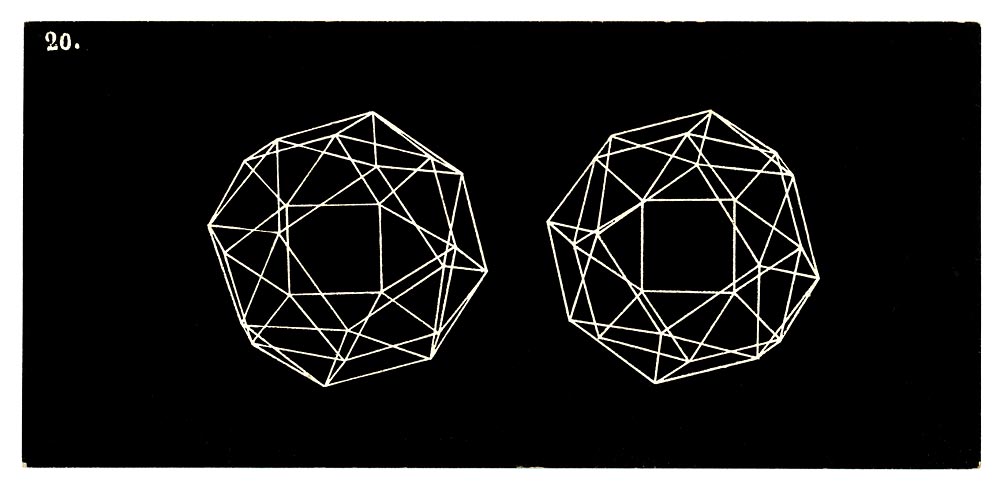
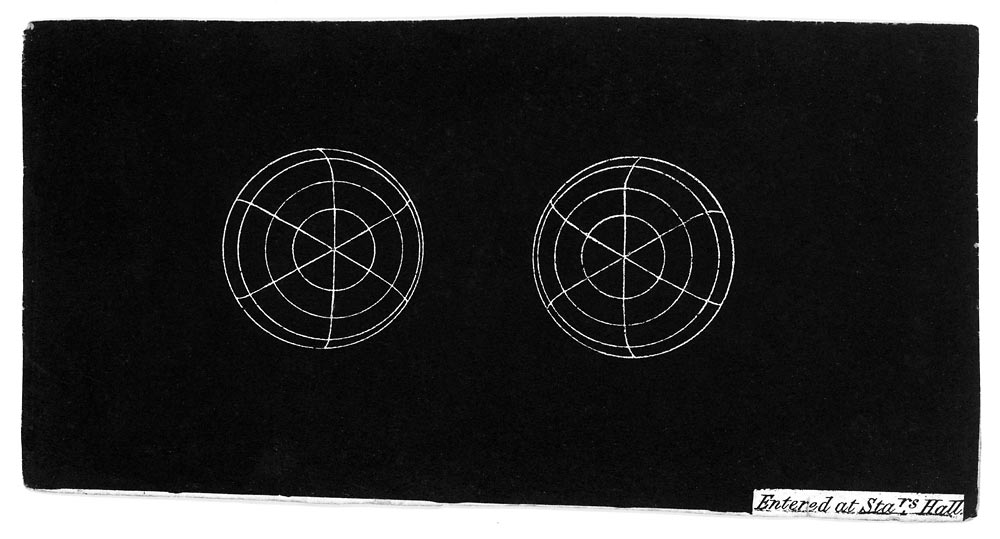
The stereoscope was no more then than another philosophical toy, like the kaleidoscope or the phenakistiscope, used to illustrate the principles of binocular vision. Although these diagrams may seem fairly lame to us, they were of great interest to the Victorians whose ever-curious mind was always trying to understand the world around them. They are also the first stereoscopic pictures they could afford and own, which made them important and precious.
Capturing depth and time
Fortunately for everyone photography made fast progress and soon stereoscopic images could be bought not only on plate but also on glass and on paper. When we look at those early stereos and compare them with what was written about them in the press at the time, we cannot but be surprised by the discrepancy between the praises one can read and the photographs we are viewing in the stereoscope. We mustn’t forget, however, that for the Victorians any stereo was a good stereo as long as it showed some depth, whether in a portrait, a group, or a landscape. They had very few images to compare with and were satisfied with compositions which, to our modern eyes, do not seem very impressive.
At the time, each half of the stereoscopic pair had to taken sequentially which added to the third dimension of the resulting image a fourth one, the passing of time. It is possible to see in a large number of those early stereoscopic photographs that things have happened between the two exposures: people or horse-drawn vehicles have moved or vanished, expressions on people’s faces have changed, the hands of clocks indicate a different time, shadows have moved to the left or to the right, seeming to poke into or out of their source, movement has become blurred and crowds look like ghosts. The latter were described in 1861 by American philosopher and essayist Oliver Wendell Holmes, one of the few people to have written extensively about the experience of looking at stereoscopic images:
Where are all the people that ought to be seen here? Hardly more than three or four figures are to be made out; the rest were moving, and left no images in this slow, old-fashioned picture […] Ghost of a boy with bundle, — seen with right eye only. Other ghosts of passers or loiterers,— one of a pretty woman, as we fancy at least, by the way she turns her face to us.5Oliver Wendell Holmes, “Sun Painting and Sun Picture” in The Atlantic Monthly, July 1861, p. 18-19.
One of my favourite of these sequential images is a view of the Cluny museum in Paris which shows a carriage drawn by a black horse on one half and, nearly at the same spot, a carriage drawn by a white horse on the other half. Another very curious example, among dozens of others, is a still life taken in a garden in which something seems wrong. It is only when you blow up the image that you realise that in one of the pictures a fly has landed on the handle of the watering can but is nowhere to be seen in the other one. That tiny insect causes a visual disruption which is in itself fascinating because although the eyes do not really see it the brain perceives something is not as it should be.
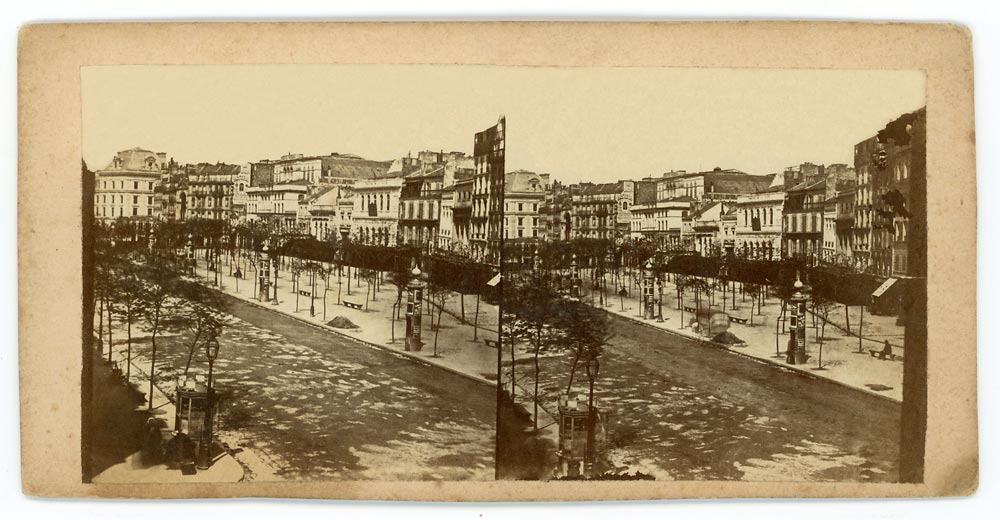
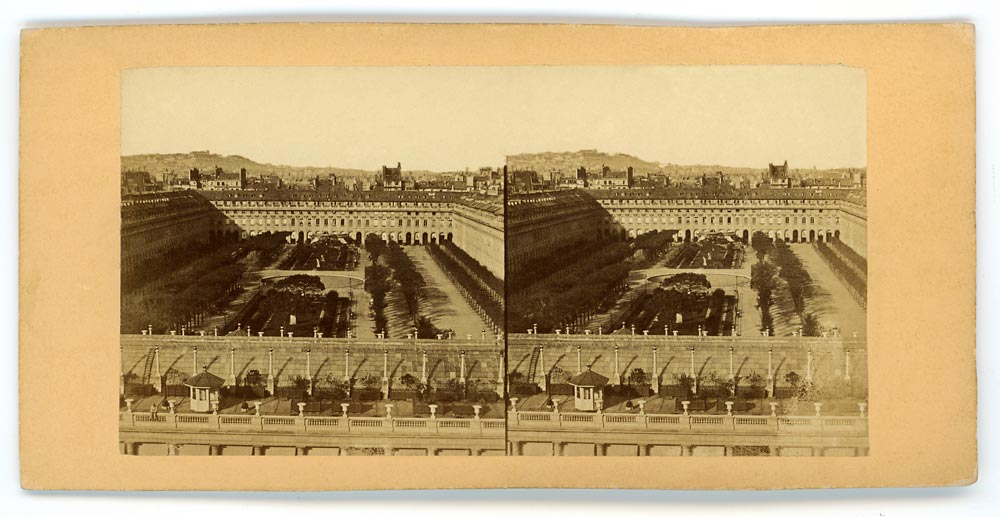

Roland Barthes was probably not thinking of stereo images when he claimed that, at the beginning of photography, “cameras, in short, were clocks for seeing”6Roland Barthes. Idem., but the first cameras used to take stereos were just that.
A lot of people do not appreciate the changes that occur between the two images in sequential stereos and it is true that sometimes they can be a bit too much, like in the example below, a scene in Berne, Switzerland, by French photographer Alexandre Bertrand. On the whole however, I find them very interesting to study on account of this fourth dimension they give to the image and the information they provide about the time that elapsed between the two exposures.
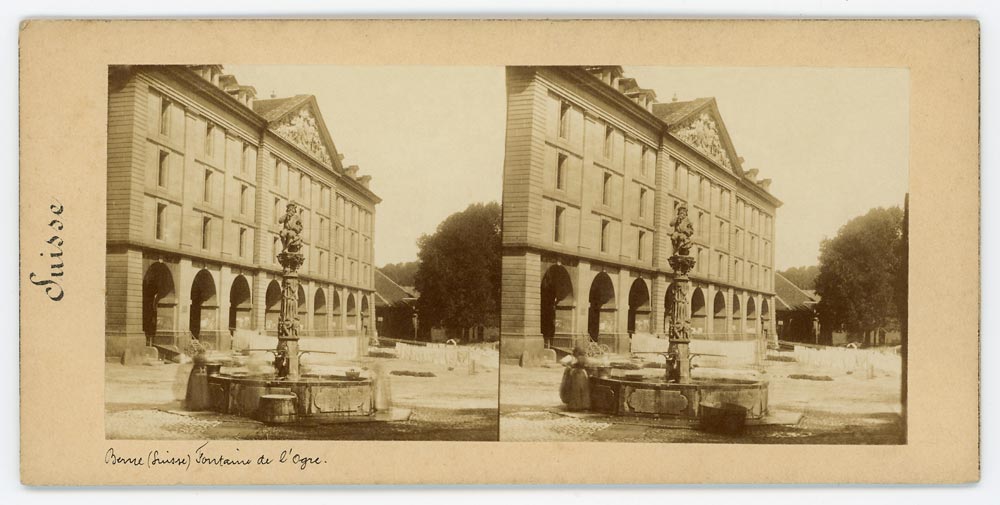
A substitute for the real thing
Travelling for pleasure in the Victorian era was only available to a small wealthy portion of the population and was not without risks. It soon became evident that, thanks to the stereoscope, a large number of people who could not afford the expense of going on a Grand Tour, could at least buy stereo cards of the places they wished to visit. By the end of 1859 most of the known world had been photographed for the stereoscope, even such mysterious lands as China and Japan, and commentators insisted on the pleasure that could be found travelling to far away places without leaving one’s fireside, even or especially when one was feeling poorly. “Thanks to the portability of these small prints”, wrote photographer Henri de la Blanchère, “the public like to travel quickly and safely to the familiar or totally unknown countries where the photographer takes them; they find it all the more enjoyable as the fatigue and the dangers are for others but the interest is theirs. The world will soon be fully explored, and it can be explored repeatedly without one’s curiosity getting weary or satiated; nature is huge and, thankfully, the thirst for knowledge has no limits.”7Henri de la Blanchère, Monographie du stéréoscope. 1860. Chapter 11, p. 19-20
Columnist La Gavinie, from the photographic journal La Lumière, was one of the many armchair tourists who took advantage of the stereoscope to go on dangerless journeys. After all he was on the payroll of the Gaudin firm to advertise their stereoscopic viewers and cards:
I have just taken a long trip through a stereoscope – I have successively visited the remotest corners of Greece and Egypt. The sick, and there are many of them this winter, must have, like myself, been plentifully entertained by the magical instrument. It played a great part in their recovery, and the cleverest doctors now prescribe it along with their medicine.8La Gavinie. “Chronique” in La Lumière, 13 Février 1858, p. 27.
As more and more stereo photographs became available it became apparent that not only those binocular images could bring back fond memories of past journeys9Charles Paul Furne and Henri Alexis Omer Tournier, La Photographie, Journal des Publications légalement autorisées. February 1859 but also that the illusion they provided was strong enough to make the observers think they had actually seen the site or monument they were looking at, even if they had never laid eyes on it. The illusion was turning into a “memory”, as Hermann von Helmholtz himself explained in his book Physiological Optics:
[…] these stereoscopic photographs are so true to nature and so lifelike
in their portrayal of material things, that after viewing such a picture and recognizing in it some object like a house, for instance,
we get the impression, when we actually do see the object, that we
have already seen it before and are more or less familiar with it. In
cases of this kind, the actual view of the thing itself does not add
anything new or more accurate to the previous apperception we
got from the picture, so far at least as mere form relations are
concerned.10Hermann von Helmholtz, Physiologial Optics, vol. 3, p. 303.
Oliver Wendell Holmes was even more radical in his views when he wrote that matter was now no more than a mould and that stereo images could literally replace anything worth seeing:
Form is henceforth divorced from matter. In fact, matter as a visible object is of no great use any longer, except as the mould on which form is shaped. Give us a few negatives of a thing worth seeing, taken from different points of view, and that is all we want of it. Pull it down or burn it up, if you please.11Oliver Wendell Holmes, “The Stereoscope and the Stereograph” in The Atlantic Monthly, June 1859, p. 747.
It unfortunately pleased the rebels of the Commune to set fire to the Tuileries Palace, which was completely destroyed in May 1871 and was deemed too strong a symbol of past monarchies to contemplate re-building. The palace, however, was extensively photographed for the stereoscope during the reign of Napoleon III so that it is still possible to get a fairly precise idea of its exterior and interior. There are actually so many images that we can virtually go through all the reception rooms – and even look around them sometimes – from the Pavillon de Flore, next to the Seine, to the Pavillon de Marsan, along the rue de Rivoli.
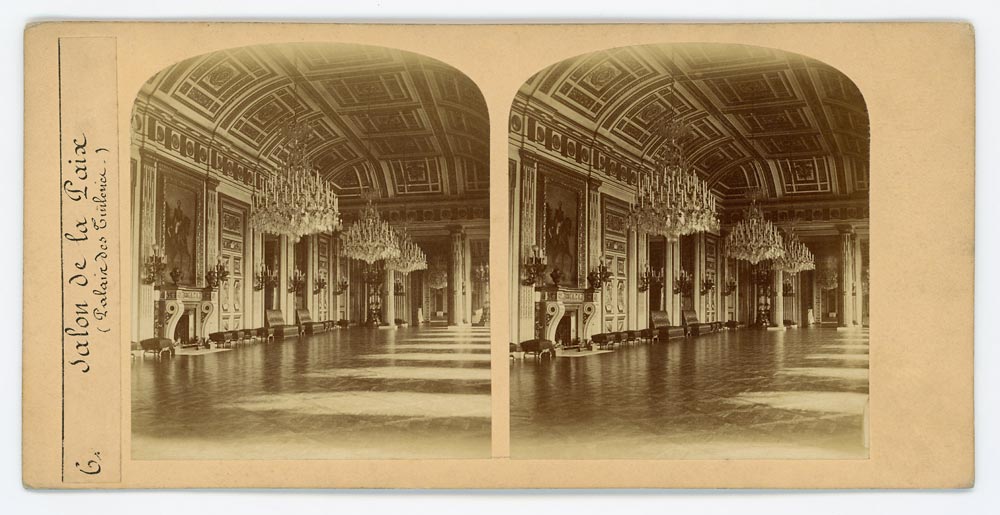
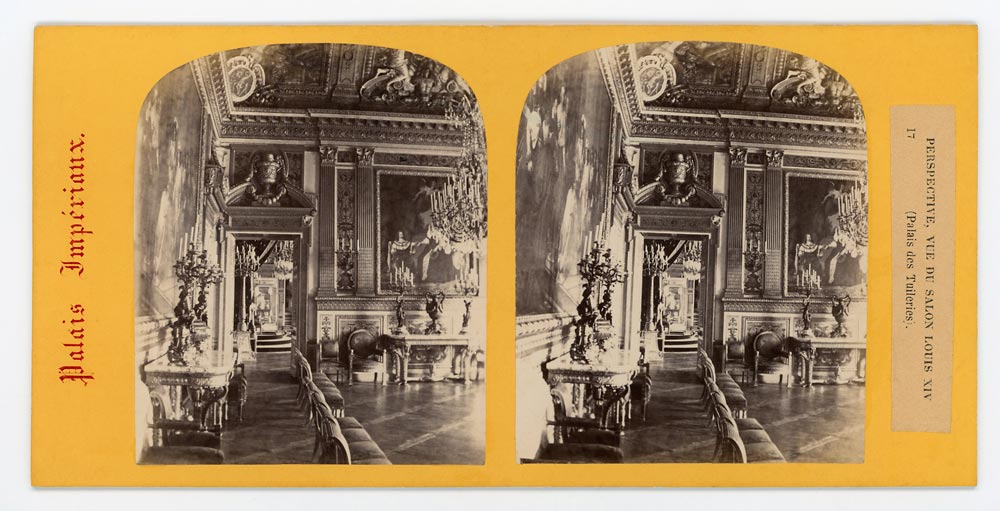
Gradually in the mind of amateurs of stereoscopic images the photograph came to be a proper substitution for the subject represented. This is clearly shown in the following lithograph by French artist Charles Édouard de Beaumont (1821-1888) published in the satirical magazine Le Charivari on 24 February 1864.
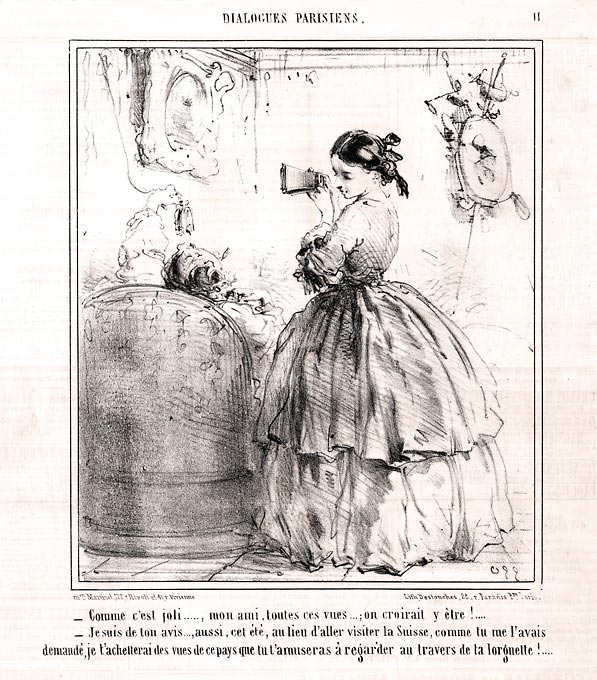
- How pretty …. All those views …. ; one could almost imagine one was there ! ….
- I totally agree with you … which is why, this summer, instead of visiting Switzerland, as you expressed the desire to, I will buy you views of that country and you will have a great time looking at them through your lorgnette ! ….
Another French cartoonist, Henri Alfred Darjou (1832-1874) chose to represent an artist on holiday, tired after the day’s hike and wishing he had stayed home and taken his ongoing trip virtually.
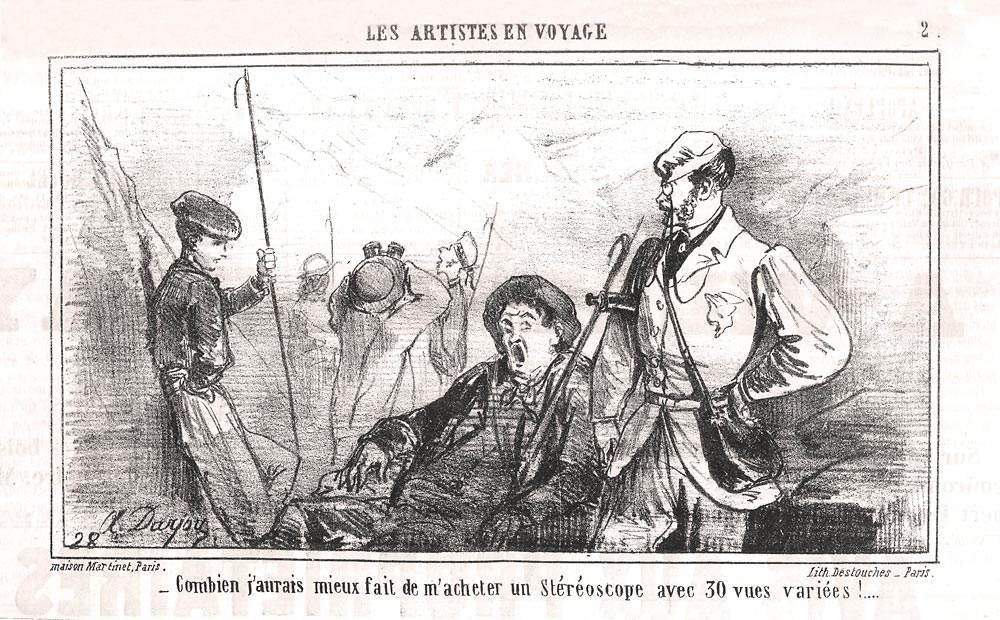
– I wish I had bought a Stereoscope and a selection of 30 views instead ! ….
Fuel for the imagination
The Victorians loved stories and especially imagining new ones from a few given clues. It is no wonder the most popular paintings of the time were of the narrative kind, a genre which gradually came to be considered as too sentimental and has been looked down upon for far too long. Apart from a few famous canvases, like Henry Wallis’s The Death of Chatterton, William Powell Frith’s Derby Day, and a few others, these works are rarely studied or displayed any more. Hundreds of narrative paintings, a lot of which unsurprisingly inspired staged scenes for the stereoscope which were hugely popular in their time, have been gathering dust in the storage rooms of museums and galleries, their current location a mystery.12If you wish to know more about the connections between narrative paintings and the stereoscope read the book by Denis Pellerin and Dr. Brian May, The Poor Man’s Picture Gallery, published by the London Stereoscopic Company. In the August 1864 issue of London Magazine of Entertainment and Instruction for General Reading, Leslie Walter tells a very strange tale which only becomes clear in the last few lines of his text when we discover that the hero of the story has been dreaming after falling asleep over some stereo pictures brought to him by his nephews.
Here, take away the stereoscope, my dears, and the pictures that I fell asleep over, after they had put so much folly into my old head. Put away the Spanish Girl, and Dressing for the Ball, and that foolish, Moonlit Balcony, and the Sea-scene, and the Ball Room, and Mr. Fechter as Hamlet, and the Refusal, and the Young Lady with the Fan, and the other on an ottoman. Put the Bride at the bottom of the box, and the Bridegroom out of my sight; and that fine view of Madrid also, and the picture of a parlour; and heaven forbid my seeing again the Nice Young Man, or the Pair of Lovers! I believe that was what did the mischief, after all.
There, put them all away, children, and never tell your aunt what nonsense your uncle talked in his sleep, after seeing your stereoscope.
THE END13Leslie Walter, “In a stereoscope”. Sharpe’s London Magazine of Entertainment and Instruction for General Reading, 25 (New Series): August 1864, pp.83-89
Stereo images did not have to be staged, however, to take hold of the buyers’ imagination, and start the narrative process. Oliver Wendell Holmes, in his iconic text The Stereoscope and the Stereograph, describes how details that could easily go unnoticed often become more important than the main subject of the picture examined in the stereoscope, making the mind wander:
We have often found these incidental glimpses of life and death running away with us from the main object the picture was meant to delineate. The more evidently accidental their introduction, the more trivial they are in themselves, the more they take hold of the imagination.14Oliver Wendell Holmes, Ibid, p. 745.
Looking at a stereo glass slide by Francis Frith showing the Pool of David, at Hebron, then at a view of the Lake of Brienz by Claude Marie Ferrier, also on glass, the same Holmes cannot get his eyes off “a muffled shape” in one and “vaguely hinted female figure” in the other:
There is before us a view of the Pool of David at Hebron, in which a shadowy figure appears at the water’s edge, in the right-hand farther corner of the right-hand picture only. This muffled shape stealing silently into the solemn scene has already written a hundred biographies in our imagination.
In the lovely glass stereograph of the Lake of Brienz, on the left-hand side, a vaguely hinted female figure stands by the margin of the fair water; on the other side of the picture she is not seen. This is life; we seem to see her come and go. All the longings, passions, experiences, possibilities of womanhood animate that gliding shadow which has flitted through our consciousness, nameless, dateless, featureless, yet more profoundly real than the sharpest of portraits traced by a human hand.15Idem.15
On the other side of the Pond, poet Charles Baudelaire was describing something very similar while looking out over the roofs of Paris at a lit window. Isn’t looking into a Brewster-type stereoscope a very similar experience? Our eyes gaze through the darkness of a closed wooden box at an image which, illuminated as it is by the light that comes through the trap door at the top of the instrument, appears as seen through a closed window (the window is definitely closed since we cannot touch the subject we are looking at however real and palpable it may seem).
Looking from outside into an open window one never sees as much as when one looks through a closed window. There is nothing more profound, more mysterious, more pregnant, more insidious, more dazzling than a window lighted by a single candle. What one can see out in the sunlight is always less interesting than what goes on behind a windowpane. In that black or luminous square life lives, life dreams, life suffers.
Across the ocean of roofs I can see a middle-aged woman, her face already lined, who is forever bending over something and who never goes out. Out of her face, her dress, and her gestures, out of practically nothing at all, I have made up this woman’s story, or rather legend, and sometimes I tell it to myself and weep.
If it had been an old man I could have made up his just as well. And I go to bed proud to have lived and to have suffered in someone besides myself.
Perhaps you will say “Are you sure that your story is the real one?” But what does it matter what reality is outside myself, so long as it has helped me to live, to feel that I am, and what I am?16Charles Baudelaire, “The Windows” in Le Spleen de Paris.
Below are the two pictures described by Holmes. By our modern standards they are far from outstanding and for most of us they would probably pass unnoticed or not be worth a second look. Would you, reader, write “a hundred biographies” from the silhouette on the right in Frith’s picture or think of “all the longings, passions, experiences, possibilities of womanhood” from the blurred shape on the left of Ferrier’s image? I know I would probably not, at least not from these two images. Have we lost that power of writing a story in our mind from a mere shadow? Have we been fed too many “processed” narratives in the shape of TV series or films that few of us can do what Holmes, Baudelaire and their contemporaries did so easily apparently? I wonder.
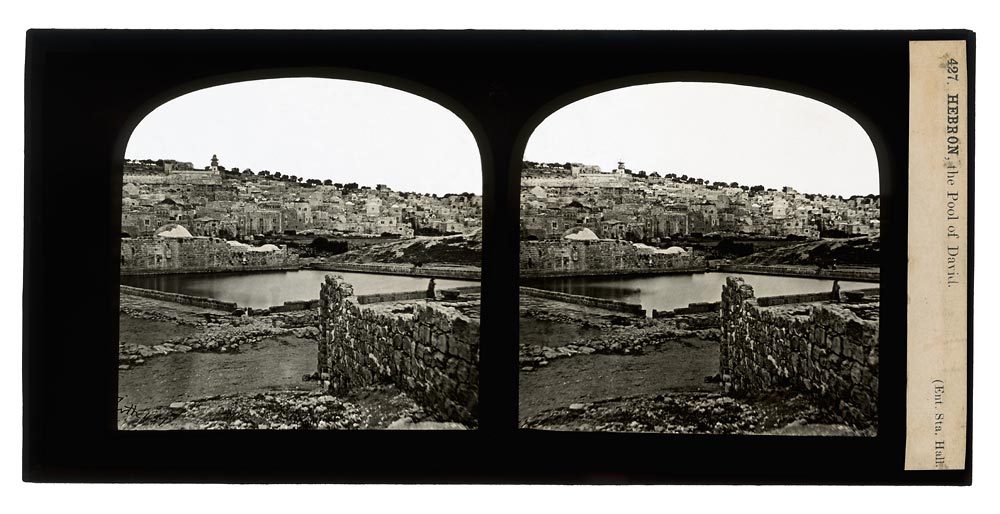
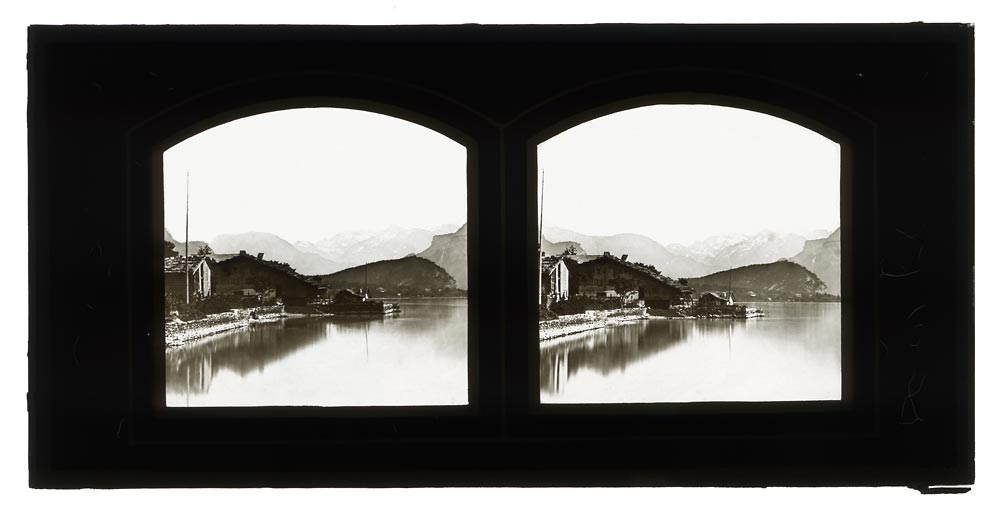
In case you might think that only a human presence could trigger the Victorians’ imagination here is another example not directly involving any men, women or children. This paragraph was written by Ernest Lacan, the editor of the photographic journal La Lumière, after examining a series of stereoviews taken in 1858 at Cherbourg by Charles Paul Furne and his cousin Henri Tournier and published under the generic title Souvenir de Cherbourg:
There is amongst Mr. Furne’s prints a true masterpiece: it is simply the view of a steamer in the Cherbourg harbour. Is it arriving? It is leaving? Is it on its way to Kamtchatka, or getting back from Honfleur? It doesn’t matter; it is sailing and floating so lightly on the transparent sea, its masts are so coquettishly tilted, the smoke from its funnel is so gracefully billowing, that our imagination feels drawn to it, and without further ado, we get on board and let ourselves be carried away towards the unknown, into the enchanted land of dreams.17Ernest Lacan, “Revue Photographique” in La Lumière, 16 October 1858, p. 166.
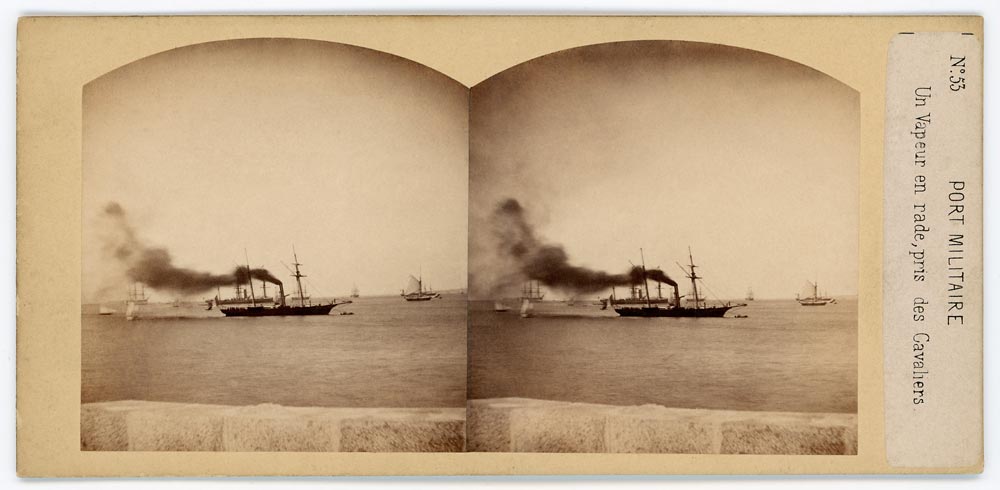
Shortly after this piece was issued in La Lumière, one of Lacan’s colleagues, a journalist from another photographic journal, Le Photographe, could not help exclaiming:
Speak of an amateur like Mr. Ernest Lacan to look with the eyes of a poet into that so unpoetical box which is called a stereoscope. Once the oculars of the instrument are close to his face, the witty editor of La Lumière does not only look into them with his eyes but also with his soul, his imagination and a little of his heart.18Le Photographe, 19 novembre 1857, p.2.
Maybe we should always follow in Lacan’s footsteps and look at every stereo with our soul, heart and imagination if we really are to understand what the Victorians saw in them. One thing is certain: we mustn’t judge Victorian stereo images by our modern standards but try and understand what their appeal was at the time they were taken, reviewed and sold, especially when they surprise us. It is very often I find myself wondering while looking at a stereo card in the stereoscope: “Why on earth was this image taken? Who would buy such an image?”. This is another thing which bears keeping in mind at all times: if we except commissioned pictures and amateur views (quite rare in the early days of the stereoscope), most stereoscopic photographs were meant to be sold. They were the first mass-produced photographic images, several years before the cartes-de-visite and decades before the first postcards. Someone took those photographs with a commercial purpose in mind and to entice more than one person to buy then. There must, therefore, have been some appeal in every single card on the market. Sometimes we have lost the original references, the key so to speak, or we must accept that our tastes are different from our forefathers’. I know for a fact that I often find that Victorian humour leaves me indifferent or that comic songs of the 1830s-40s, even the most popular ones, fail to amuse me.
Voyeurism or “concentration of the whole attention” ?
Some modern commentators have insisted on the voyeuristic nature of the stereoscope and the picture below, copyrighted by American photographers William Herman Rau in 1903, clearly shows that photographic artists were aware of the fact and used it to their advantage. There was a booming underground industry which specialised in the making of nudes for the stereoscope in the Paris of Napoleon III and exported its productions all over the world. Despite the re-establishment of censorship, the fines and the prison sentences they received, a lot of photographers and female models found this very specific branch of stereoscopy very lucrative and most of them bore the consequences with equanimity.19Denis Pellerin has devoted a whole book to stereoscopic nudes and what happened to the photographers and models who specialised in them. Called History of Nude in Stereo Daguerreotypes, Collection W. + T. Bosshard, it was published in 2020 in English, German and French. The main drawback of this state of things was that it gave the stereoscope a bad name which, to this day, has not been totally cleared.
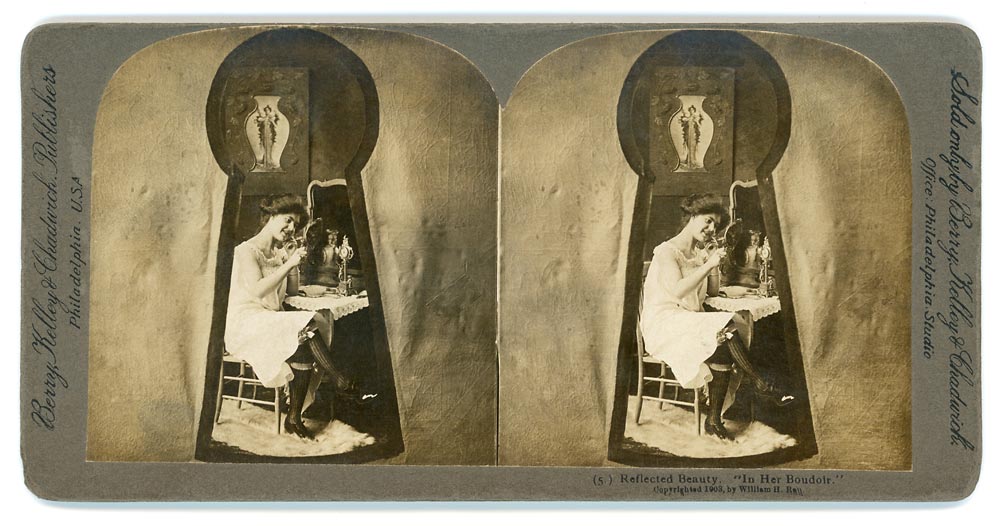
Even when stereo photographers were not featuring women in various states of undress, they still managed to emphasise the voyeuristic nature of the stereoscopic observation in scenes such as the ones below. In both images we are looking at a man gazing at the ankles of a young woman (a highly erotic part of the female anatomy in the Victorian era), who is totally unaware of his presence. This could be called double voyeurism in a way since the stereoscopic observer can see both the looker and the person looked at and even has a better view of said ankles.
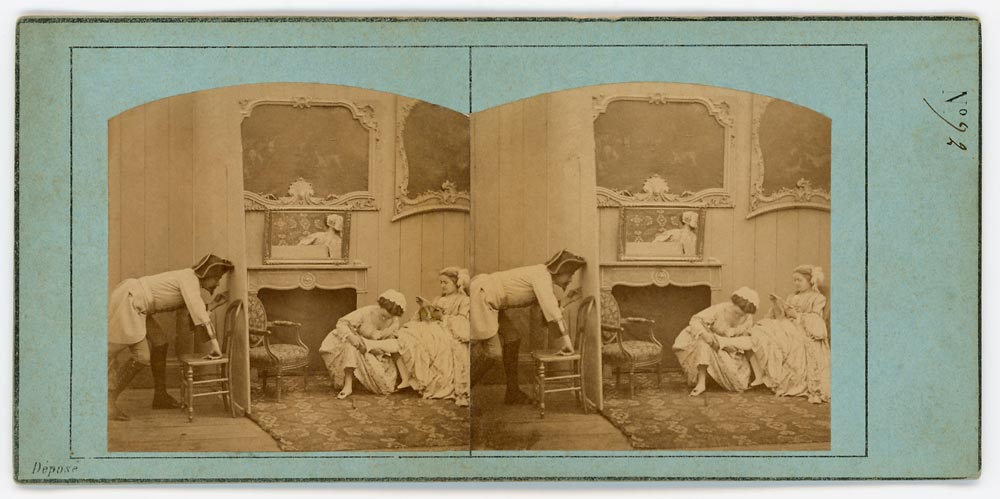
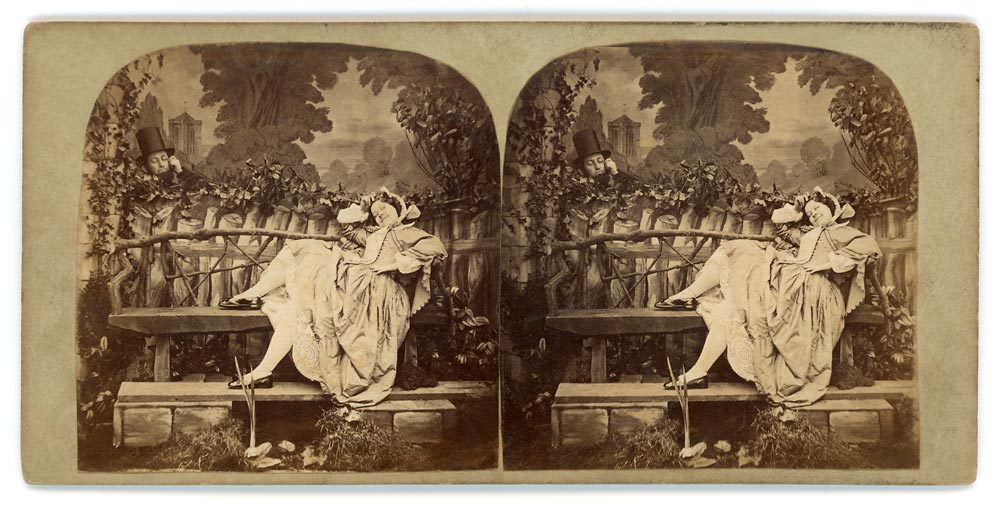
However, these images are not representative of the stereoscopic production and what could be termed a “voyeuristic gaze” for some was, for the majority of observers, more of a “concentration of the whole attention” which produced “a dream-like exaltation of the faculties, a kind of clairvoyance, in which we seem to leave the body behind us and sail away into one strange scene after another, like disembodied spirits.”20Oliver Wendell Holmes, “Sun Painting and Sun Picture” in The Atlantic Monthly, July 1861, p. 15. (my italics)
It would be difficult otherwise to explain the existence of dozens of pictures like the one below, featuring open bibles. These images are mostly to be found in Britain and in the States, two countries where bibles would, at the time, have been found in the great majority of homes and were, for a lot of people, the only book that they would read. Why then would anyone take the trouble of photographing an open book with some selected accessories (the most common ones being a bookmark, candles, an hourglass, a pair of glasses, a magnifying glass, a glass of water, an ink well with a quill dipped in it, some flowers)? Who would buy them? My guess is that, in a world which was expanding and with a pace of life which was quickening, people felt the need for something to make them stop and introspect, something very similar in a way to today’s meditation apps. These images suited that purpose perfectly. Once inserted in a stereoscope they became a sort of private and portable little chapel in which one was alone with one’s thoughts and one could concentrate on one’s life and meditate on the words that could easily be read on the displayed pages. In most pictures the bible is open at different places, the Book of Isaiah, the Book of Proverbs, or the Prophecy of Haggai, to name but a few, but the majority, however, feature some part of the Book of Psalms. This is definitely no voyeurism and totally a concentration of the observer’s whole attention.
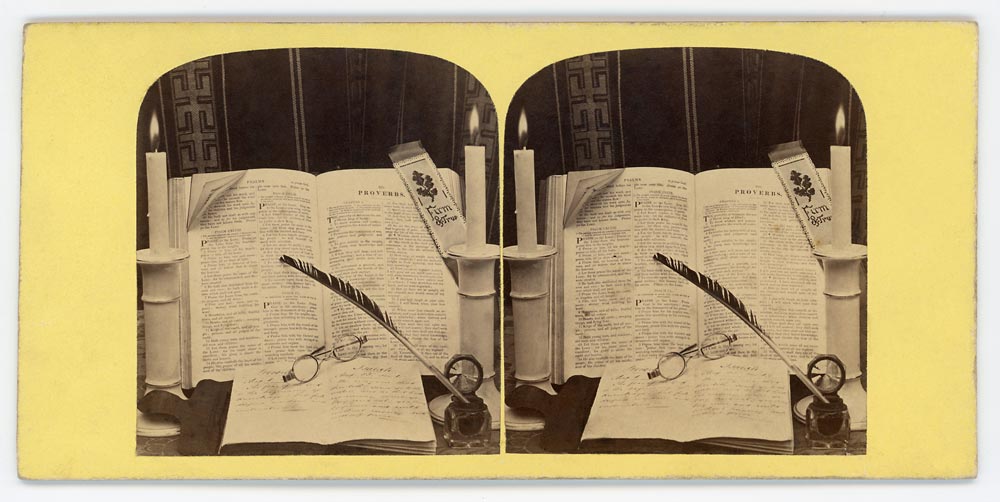
A personal note
I have met people who, because they have seen a couple of hundred stereoscopic images, think they know everything about stereoscopy and become self-appointed “experts” on the subject. I have been studying, researching and writing about these images for over forty years; I have literally seen millions of them in public and private collection; I think I know a thing or two about them and the people who took, published or distributed them, but there is even more that I do not know and I certainly do not see myself as an expert, only as a perpetual and humble student on a never-ending quest (the best kind); there is not a week that goes by without my finding images I have never seen before or coming across snippets of information that make me question what I thought I previously knew. The most important thing, however, is that, after all those years, the magic is still intact and I feel the same elation when I insert a new image in the stereoscope and spend some time exploring its various layers. I bought the cartoon below very recently because it is always nice to find new images showing people looking through a stereoscope. However, I don’t agree with the caption which reads: “The thrill that comes once in a lifetime!” For me the thrill, thrills actually, come every single time I insert a card in a stereoscope. First there is a thrill of anticipation and then, hopefully, comes the thrill of being drawn into the picture and of discovering another world. Ocasionally there is a third thrill, the one that comes when you unexpectedly find an inscription, a detail that could not be seen in the flat card, like Fenton’s photographic carriage in a view published in the Stereoscopic Magazine, the face of a familiar model in a staged scene, etc.
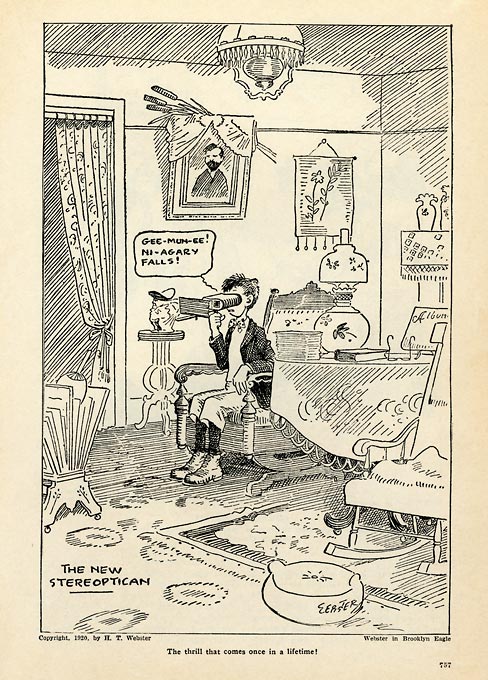
I find all stereos interesting, to a point of course, and all stereograms, great or shabby, should be given the chance to be free-viewed or examined in an appropriate viewer. And not just once, for I agree with Oliver Wendell Holmes when he writes that “it is a mistake to suppose one knows a stereoscopic picture when he has studied it a hundred times by the aid of the best of our common instruments.”21Oliver Wendell Holmes. “The Stereoscope and the Stereograph” in the Altantic Monthly, June 1859, p. 744. Images that look grubby and faded have a way of “fixing” themselves when seen in a stereoscope. Our wonderful and malleable brain picks up pieces of data in each half and fuses them into something that is much more that the sum of their parts. Simply because we are not looking at the surface of the picture but at something beyond it the grubbiness usually disappears, not completely but enough to make the image more appealing and to enable us to discover details which had been invisible before. And after all the grubbiness is part of the card’s history. It speaks of all the hands it has gone through, of the parlour table it has been lying on, of the soot that fell on it. Unlike framed photos and images stuck in albums and rarely looked at again, most stereo cards have had a busy social life and have been shared over and over again.
I have read a lot about the Victorian era and I guess it helps me understand, most of the time, what I am looking at and appreciate the value of each image. Not the monetary value of course, although there are some very greedy sellers around who would have you believe that any stereo card which is more than fifty years of age is worth more than its weight in gold, but the historical, sociological or photographical value of the image, the information it brings, the details it reveals, its composition along the depth axis, or the simple stories it often tells about the subject photographed and, occasionally, about the photographer. There are still plenty of occasions when what I am looking at baffles me and I wish I could get more clues from the view itself or from the faces of the people I discover there. If stereos could speak ! How much more would be understood about these fascinating images. Since they cannot, we must keep looking for more clues, more information, more facts, publish more articles, more books, because, from time to time, something comes up that adds a piece to this gigantic jigsaw puzzle. Can I experience stereo cards the way the Victorians did? I don’t think so, but I strive to find some tips in the writings of the time that can help me better understand their state of mind, what made them tick, what captured their attention and grabbed their imagination. I keep trying and will keep on doing so. And in the meantime, I can only second Oliver Wendell Holmes’ passionate declaration:
Oh, infinite volumes of poems that I treasure in this small library of glass and pasteboard!….22Ibid, p. 745.
